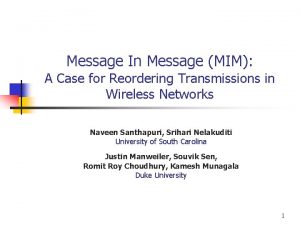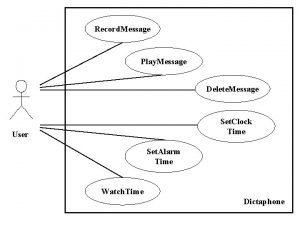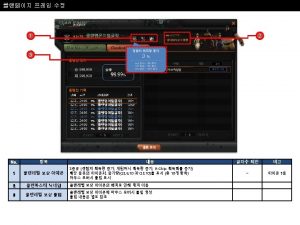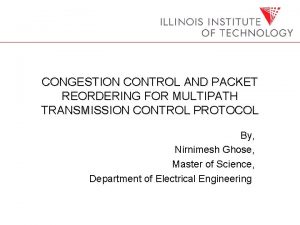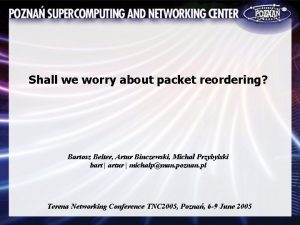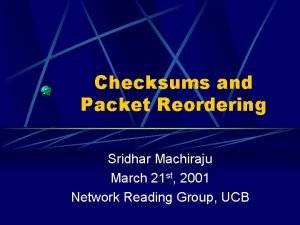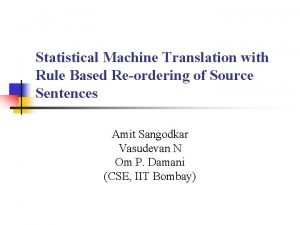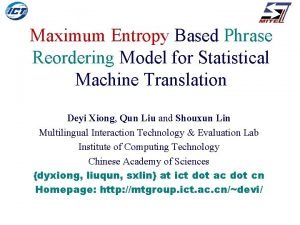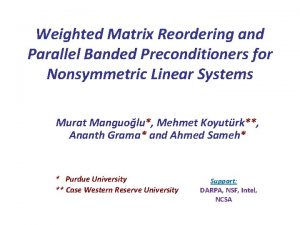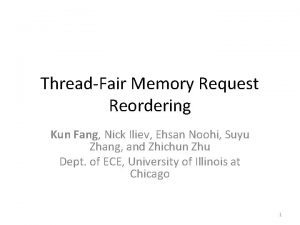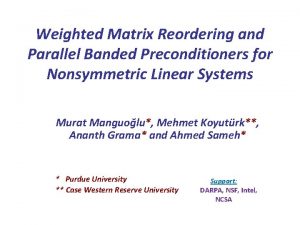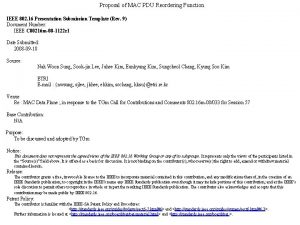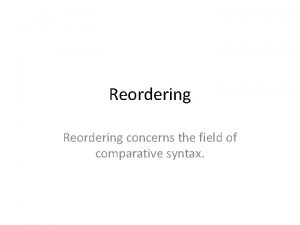Message In Message MIM A Case for Reordering




![PHY Capture n n [Kochut: ICNP 04] Interference may not always cause collisions Possible PHY Capture n n [Kochut: ICNP 04] Interference may not always cause collisions Possible](https://slidetodoc.com/presentation_image/354ef2ee38c24a9b507f4da3f142462f/image-5.jpg)






























- Slides: 35

Message In Message (MIM): A Case for Reordering Transmissions in Wireless Networks Naveen Santhapuri, Srihari Nelakuditi University of South Carolina Justin Manweiler, Souvik Sen, Romit Roy Choudhury, Kamesh Munagala Duke University 1

Outline n Motivation n Contributions n n n Understanding MIM How transmission order affects spatial reuse? Validate benefits of ordering Design MIM aware scheduling framework Future work on MIM and SIC 2

Collision n Signal of Interest (So. I) successful n n n R 1 When SINR is substantially higher And, So. I arrives earlier than Interference Else, collision Collision R 2 So. I Interference 3

Collisions affect Spatial Reuse n MAC protocols designed to avoid collisions n n 802. 11 physical carrier sensing RTS/CTS Greatly limits spatial reuse 4
![PHY Capture n n Kochut ICNP 04 Interference may not always cause collisions Possible PHY Capture n n [Kochut: ICNP 04] Interference may not always cause collisions Possible](https://slidetodoc.com/presentation_image/354ef2ee38c24a9b507f4da3f142462f/image-5.jpg)
PHY Capture n n [Kochut: ICNP 04] Interference may not always cause collisions Possible to decode So. I with higher SINR n If So. I arrives within preamble of Interference Preamble 20 us Interference Signal of Interest n Preamble time small (20 us in 802. 11 a) n Benefits small as well 5

Message In Message (MIM) n While receiving a message n n n Receiver looks for new message preamble Stronger Message extracted while receiving ongoing Message Requires higher SINR than when SOI arrives earlier Preamble Interference Signal of Interest n Capability exists in Atheros chipsets 6

802. 11, Capture, and MIM Preamble a) So. I Interference b) So. I Interference d) c) So. I Interference Successful Reception Yes/No (SINR Threshold needed to avoid collision) 802. 11: Yes (10 d. B) No No PHY Capture: Yes (10 d. B) No MIM: Yes (10 d. B) Yes (20 d. B) Different thresholds based on frame ordering 7

Link Ordering Matters Data AP 1 R 1 Controller AP 2 R 2 Data AP 2 AP 1 20 d. B AP 1 R 1 Data 10 d. B R 2 AP 2 R 2 Data R 1 AP 1 transmissions must start first, In general weaker Followed by staggered transmission from AP 2 stronger receiver can recover signal with MIM Allows weaker link R 1 to lock on to signal at low SINR 8

Measurements Rx Tx Order doesn’t affect delivery 1 2 3 4 5 Interferer Order affects Observe that 802. 11 does not enforce the order and delivery ratio thus fails to exploit concurrency

MIM Capable vs MIM Aware n MIM Capable n n Network card can recover MIM Current MAC does not exploit MIM Appropriate ordering happens by chance MIM Aware MAC n n MAC layer harnesses MIM capability Enforces appropriate ordering of transmissions 10

Goal n n Design MIM aware scheduling that reorders transmissions for improving concurrency Research Questions n n n Does MIM awareness yield significant benefits? What is the bound on improvement? How to effect the appropriate order? 11

Optimality Analysis n Integer Programming Formulation in CPLEX Optimal benefits from MIM significant 12

MIM Aware MAC n Shuffle n n n Centralized MIM-aware scheduling protocol For Enterprise Wireless LANs (EWLAN) Why EWLAN? n Increasingly popular architecture n Realizes potential of MIM Controller AP 1 AP 2 AP 3 13

Shuffle: Assumptions n Dominant downward traffic n Powerful controller, Gigabit Ethernet n n Low latency for scheduling/communication Additive Interference n Total = sum of individual interferences 14

Shuffle: Components n n Rehearsal: Measuring interference relations Packet Scheduler n n Use rehearsal and MIMconstraints Output transmission schedules (ordered) Rehearsal Interference Relations Packet Queue Scheduler n Schedule Executer MIM Constraints Ordered Transmissions 15

Measuring Interference Relationships n Periodic Rehearsals n n n APs transmit probes at base rate Each client replies with RSSI values APs too record RSSI values from clients Controller derives interference map Opportunistic rehearsal n n Piggyback RSSI values in data transmissions Continually refine interference map 16

MIM-Aware Scheduler n Objective n n n With MIM, conflicts are asymmetric n n n Maximize concurrency Avoid starvation Conflict graph methods unsuitable Optimal link scheduling is NP-hard Least conflict greedy heuristic n n n Score links based on asymmetric conflicts Links that prevent other links assigned higher score Compute link order based on ‘lower score first’ 17

Batch Selection & Dispatch Batch P 31 Controller P 22 P 32 AP 3 AP 2 AP 1 P 31 P 13 P 12 P 21 P 13 R 11 R 21 R 12 R 13 R 22 R 31 R 32 18

Schedule Execution P 31 Controller P 22 P 31 P 13 P 21 P 32 AP 1 AP 2 AP 3 P 12 R 11 R 21 R 12 n R 13 R 22 R 31 R 32 APs transmit at specified time n DATA Staggering order: AP 1 -AP 3 -AP 2 19

Evaluation n Qualnet simulations n n Throughput and the effect of Fading Parameters n n n 802. 11 a physical model with MIM PLCP: 20 us Fading: Ricean, varying K factor Wired backbone: 1 Gbps ethernet Controller processing latency: 50 us 20

Duke EWLAN Topologies n Client, AP placement traces used to derive topologies (topo 1, topo 2, etc. ) 21

Throughput Comparision Higher gains with Shuffle Gain with scheduling 22

Increasing AP Density n AP density yields higher benefit from Shuffle 23

Impact of Channel Fading n Better throughput gain at lower (Ricean) fading 24

Related Work n Location aware 802. 11: Infocom 05 n n CMAP: NSDI 08 n n Takes advantage of MIM but not ordering Partially benefits from MIM capable hardware Speculative Scheduling for EWLANs: Mobicom 07 n Doesn’t consider MIM 25

Looking Forward n MIM helps recover if So. I is stronger n What if So. I is weaker than interference? n n MIM cannot help Successive Interference Cancellation 26

Successive Interference Cancellation n SIC can be used to recover weaker So. I n n First extract stronger frame Subtract it from the combination Recover weaker frame from residue Feasibility depends on n Strengths of So. I and Interference 27

Interplay of MIM and SIC n Ordering helps SIC too n n If Interference (I) moderately stronger than So. I n Initiate I first to take advantage of MIM n Decode I If I much stronger than So. I n Initiate So. I before I n So. I characterized better for decoding later 28

fir st , S 1 , S Banod 2 de t h. S 2 , S l co oslo 1, da t st S 2 bl de e co da bl e S 2 later S 1, S 2 decodable Rx S 2 Tx 1 Tx 2 st S 1 fir th Bo S 2 too weak to satisfy SNR S 1 S 2 S 1 not decodable RSS of S 2 Characterization & Cancellation S 1 Later S 1, S 2 decodable S 2 not decodable RSS of S 1 29

Future Work n Shuffle n n Implementing and deploying on a test-bed Integrating upload traffic Comparing with other schemes SIC vs MIM n n Explore Characterization vs. Cancellation Advantage of reordering transmissions 30

Thank you 31

Coping with Fading Loss n Immediate corrective rehearsal n n Controller identifies links suspected of fading Schedules a packet batch only for these APs This is a partial rehearsal n Packets are transmitted in serial order n n n APs and clients unaware, send Data and ACKs Controller updates Interference map from ACK RSSIs 32

Idea to explore with SIC n Power Control to enable SIC n n Suppose SINR threshold is 10 d. B SINR is 1 d. B -60 d. Bm -59 d. Bm Tx 1: tx power = 100 m. W Tx 2 33

Idea to explore with SIC n Power control to enable SIC n n Suppose SINR threshold is 10 d. B SINR is 10 d. B after Tx 1 reduced transmit power -60 d. Bm -70 d. Bm Tx 1: tx power = 10 m. W Tx 2 34

Limitations of Capture n Capture does not help when n So. I arrives after the preamble of interference i. e. Receiver locks on to interference Preamble 20 us Interference Signal of Interest n Preamble time small (20 us in 802. 11 a) n Benefits small as well 35
 Best worst and average case
Best worst and average case Densitet vatten
Densitet vatten Ministerstyre för och nackdelar
Ministerstyre för och nackdelar Bamse för de yngsta
Bamse för de yngsta Verktyg för automatisering av utbetalningar
Verktyg för automatisering av utbetalningar Nationell inriktning för artificiell intelligens
Nationell inriktning för artificiell intelligens Sju principer för tillitsbaserad styrning
Sju principer för tillitsbaserad styrning Kanaans land
Kanaans land Romarriket tidslinje
Romarriket tidslinje Nyckelkompetenser för livslångt lärande
Nyckelkompetenser för livslångt lärande Datumr
Datumr Ledningssystem för verksamhetsinformation
Ledningssystem för verksamhetsinformation Delegerande ledarstil
Delegerande ledarstil Matematisk modellering eksempel
Matematisk modellering eksempel Vishnuiter
Vishnuiter Centrum för kunskap och säkerhet
Centrum för kunskap och säkerhet Personalliggare bygg undantag
Personalliggare bygg undantag Aktiv expektans
Aktiv expektans Jag har nigit för nymånens skära
Jag har nigit för nymånens skära Inköpsprocessen steg för steg
Inköpsprocessen steg för steg Strategi för svensk viltförvaltning
Strategi för svensk viltförvaltning Standardavvikelse formel
Standardavvikelse formel Datorkunskap för nybörjare
Datorkunskap för nybörjare Tack för att ni har lyssnat
Tack för att ni har lyssnat Returpilarna
Returpilarna Läkarutlåtande för livränta
Läkarutlåtande för livränta Treserva lathund
Treserva lathund Tack för att ni lyssnade
Tack för att ni lyssnade Påbyggnader för flakfordon
Påbyggnader för flakfordon Egg för emanuel
Egg för emanuel Tobinskatten för och nackdelar
Tobinskatten för och nackdelar Tack för att ni har lyssnat
Tack för att ni har lyssnat Var finns arvsanlagen
Var finns arvsanlagen Lågenergihus nyproduktion
Lågenergihus nyproduktion Tidbok yrkesförare
Tidbok yrkesförare Rutin för avvikelsehantering
Rutin för avvikelsehantering




































